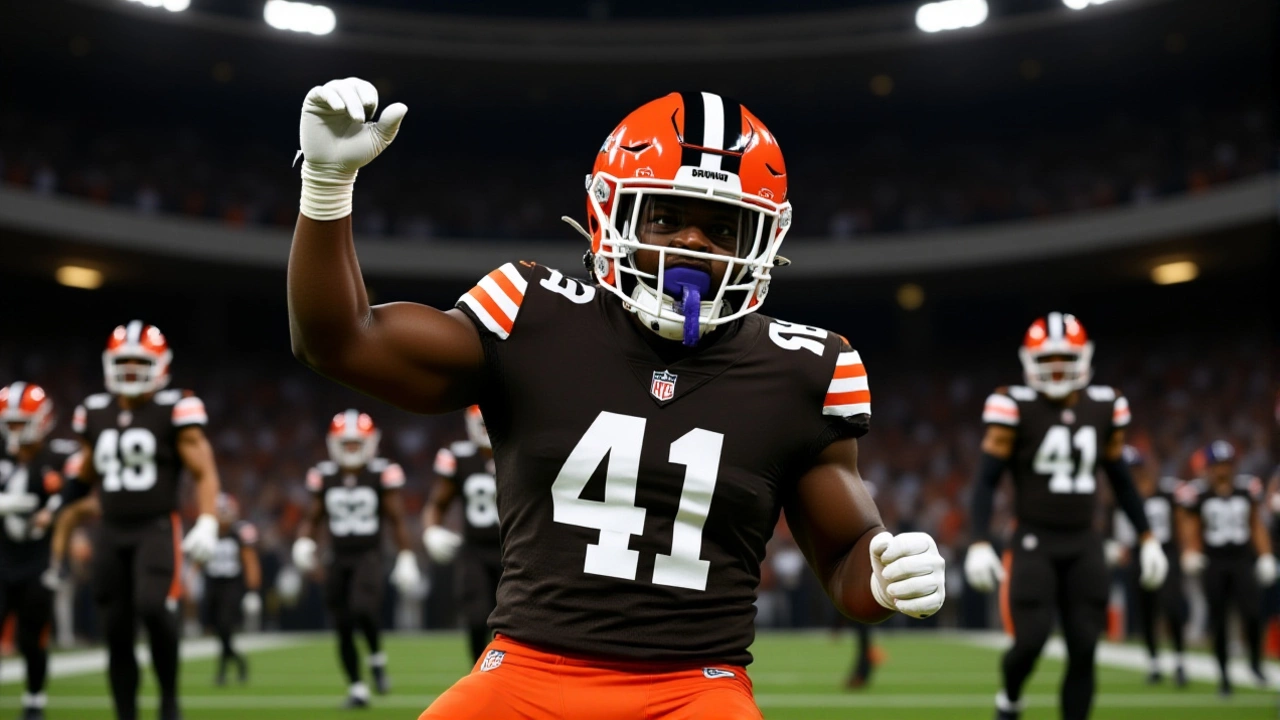On Sunday, November 23, 2025, Shedeur Sanders stepped onto the field as the Cleveland Browns’ starting quarterback for the first time in his NFL career — and delivered a performance that silenced some critics, even if it didn’t fully satisfy others. The 23-year-old rookie, selected 144th overall in the 2025 NFL Draft, completed 11 of 20 passes for 209 yards, one touchdown, and one interception in a 24-10 win over the Las Vegas Raiders. It wasn’t flawless. But for a franchise that’s cycled through 30 starting QBs since 1999, it was the kind of spark they haven’t seen in years.
Why This Start Mattered More Than the Score
The Browns weren’t just playing for a win. They were playing for continuity. With incumbent starter Gabriel still in the NFL’s concussion protocol after six starts this season, the team had no choice but to turn to Sanders. What followed wasn’t a miracle — but it was a revelation. The offense, under head coach Kevin Stefanski, leaned hard on a run-heavy, quick-passing game plan. And Sanders, for the first time in his professional life, looked like he belonged.
His 52-yard connection with rookie wideout Isaiah Bond was a thing of beauty — timing, touch, trust. But the real statement came on the 66-yard touchdown to running back Dylan Sampson. Bleacher Report’s Brent Sobleski called it “nothing more than a simple swing pass,” but that’s the point. Sanders didn’t try to do too much. He trusted the scheme. He trusted his blockers. And he trusted his receivers.
What Changed From College to the NFL?
At Colorado, Sanders was known for his arm talent — and his tendency to evade pressure by stepping out of the pocket. Too often, he’d float throws under duress or hold onto the ball too long. But against the Raiders, he did something unexpected: he stood tall. He stepped into throws. He got rid of the ball before the rush arrived. He didn’t panic when the pocket collapsed.
“He’s clearly a more talented playmaker than Gabriel,” Sobleski wrote. “That’s not even in question.” Gabriel’s six starts this season exposed physical limitations — a lack of arm strength on deep throws, slow processing under pressure, and an inability to move the chains consistently. Sanders, by contrast, moved with poise. He didn’t need to be perfect. He just needed to be competent. And for the first time since 2018, the Browns had a quarterback who didn’t look like a liability.
The Coaching Staff’s Calculated Gamble
Stefanski didn’t hand Sanders the keys to the offense out of desperation. He gave him a system designed to win, not to showcase. The Browns ran the ball 38 times — 188 yards, two touchdowns — and kept the Raiders’ defense guessing. The passing game was built on timing routes, slants, and quick outs. No deep bombs. No hero ball. Just execution.
“It was a solid gameplan involving a good run game and quick hitters,” Sobleski noted. “Sanders didn’t have to carry the offense. He just had to manage it.” That’s exactly what he did. The interception came on a slightly overthrown out route — a rookie mistake. But the rest? Clean. Controlled. Calm.
And yet, Stefanski refused to anoint Sanders as the starter moving forward. “We’ll evaluate everything,” he said after the game. The message? Don’t get ahead of yourself.
A Franchise That Can’t Catch a Break
Let’s be honest: the Browns’ quarterback history isn’t just bad — it’s tragic. Since returning to the NFL in 1999, they’ve had 30 different starters. Thirty. The franchise has drafted top-10 picks, traded for veterans, signed free agents, and cycled through undrafted gems. None have stuck. None have delivered.
“They’ve taken 42 steps backward over the last 26 years,” Sobleski said. That’s not hyperbole. It’s a ledger. Every failed experiment, every broken contract, every season that ended in disappointment — it adds up. This win? It’s not a championship. It’s not even a playoff clincher. But for the first time in over a decade, the Browns have a quarterback who doesn’t look like the next chapter in their long, painful story.
Sobleski gave Sanders a B grade. “He completed 11 of 20 passes for 209 yards, a touchdown and an interception in the 24-10 win,” he wrote. “The franchise should not be ready to anoint him as anything — and it isn’t.” Fair. But here’s the twist: the Browns don’t have to anoint him. They just have to let him play.
What’s Next for Sanders and the Browns?
The Browns sit at 7-4 after the win, with six games left. They’re in the thick of the AFC playoff race. If Sanders starts again — and he almost certainly will — the pressure won’t be on him to be the savior. It’ll be on him to keep doing what he did against the Raiders: make smart decisions, move the chains, and avoid mistakes.
And if he does? The Browns might finally have something they haven’t had since before the turn of the millennium: a quarterback they can build around. Not a stopgap. Not a placeholder. A real answer.
Behind the Numbers: Sanders’ Debut in Context
- 209 passing yards: Most by a Browns QB in his first start since 2016 (DeShone Kizer, 227)
- 11 completions on 20 attempts: 55% completion rate — below league average, but acceptable for a rookie in a controlled system
- 66-yard TD to Dylan Sampson: Longest scoring play by a Browns rookie QB since 2018
- First career NFL start: First time since 2020 that a Browns QB made his debut start in a win
- 30 different starting QBs since 1999: NFL record for most by a single franchise in that timeframe
Frequently Asked Questions
How does Shedeur Sanders’ debut compare to other rookie QBs in Browns history?
Sanders’ 209 yards and one touchdown in his first start are among the best for a Browns rookie QB in a win since 2016. Unlike DeShone Kizer in 2017, who threw three interceptions in his debut, Sanders avoided critical mistakes. He also didn’t rely on big-play luck — his 66-yard TD was the result of a well-designed play, not a broken coverage. This level of control is rare for a first-time starter in Cleveland.
Why didn’t the Browns start Sanders earlier if he’s clearly better than Gabriel?
The Browns’ coaching staff, led by Kevin Stefanski, prioritized stability over potential. Gabriel, despite his limitations, had experience in the system and was seen as a safer option early in the season. Only after Gabriel’s concussion and three consecutive losses did the team seriously consider a change. Sanders’ debut was less about proving he’s better — and more about proving the system can work with him.
What does this mean for the Browns’ future draft strategy?
If Sanders continues to show growth, the Browns can shift focus from quarterback to other needs — like offensive line, secondary, or edge rushers — in the 2026 draft. Instead of using a top-10 pick on another QB, they could target depth or upgrade around Sanders. That’s the dream: finally having a QB who doesn’t force the franchise to rebuild around him every two years.
Is Brent Sobleski’s ‘B’ grade fair?
Yes. A B reflects competence, not brilliance. Sanders didn’t wow with elite throws or game-breaking runs. He made the right reads, avoided sacks, and delivered when needed. For a franchise that’s seen too many A+ prospects flame out, a B is a win. The real test comes in Week 13 — not against a struggling Raiders defense, but against a playoff-caliber team.
What’s the historical significance of this win for the Browns?
It’s the first time since 2018 that a Browns QB made his first start in a win. More importantly, it’s the first time since 2004 that a rookie QB showed enough promise to make fans believe the franchise might finally have a long-term solution. The Browns have lost 18 of their last 20 games when starting a new QB. This win breaks that pattern — and that’s monumental.
Could this start change how the NFL scouts future QBs?
Possibly. Sanders was criticized in college for being too reliant on athleticism and slow to process pressure. His NFL debut showed he could adapt — stepping into throws, trusting his reads, and using the system. Scouts may now value QBs who can adjust to NFL schemes over pure physical tools. It’s a subtle but important shift: intelligence over arm strength.



